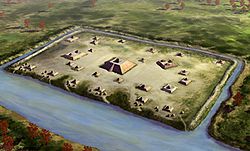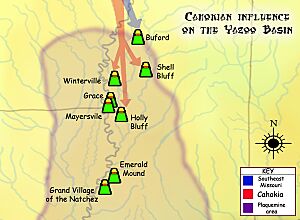Holly Bluff site facts for kids

An illustration of what the Holly Bluff site may have looked like. Artist Herb Roe
|
|
| Location | Holly Bluff, Mississippi, Yazoo County, Mississippi, |
|---|---|
| Region | Yazoo County, Mississippi |
| Coordinates | 32°48′50.77″N 90°40′58.62″W / 32.8141028°N 90.6829500°W |
| History | |
| Founded | 800 |
| Abandoned | 1500 |
| Periods | Plaquemine Mississippian |
| Cultures | Plaquemine culture |
| Site notes | |
| Excavation dates | 1908, 1928, 1936, 1949, 1958-1960 |
| Archaeologists | Clarence Bloomfield Moore, Philip Phillips, James A. Ford, Paul Gebhard, Nick Zeigler in |
| Architecture | |
| Architectural styles | platform mound |
| Architectural details | Number of temples: 25 |
|
Holly Bluff site
|
|
| NRHP reference No. | 66000412 |
| Significant dates | |
| Added to NRHP | October 15, 1966 |
| Designated NHL | July 19, 1964 |
| Responsible body: Private | |
The Holly Bluff site is an ancient place in Mississippi. It is also known as the Lake George Site or "The Mound Place." This important archaeological site helps us understand the Plaquemine culture, a group of people who lived long ago.
This site was a meeting point between two big ancient cultures. These were the Mississippian culture from the north and the Coles Creek culture and Plaquemine cultures from the south. The site was first dug up by Clarence Bloomfield Moore in 1908. Later, Philip Phillips, Paul Gebhard, and Nick Zeigler tested the site in 1949.
In 1964, the Holly Bluff site was named a National Historic Landmark. Its mounds are also part of the Mississippi Mound Trail.
Contents
Where is Holly Bluff?
The Holly Bluff site is one of the biggest ancient sites in Mississippi. It sits on the south bank of George Lake, also called Lake George. This is about half a mile east of where the lake meets the Sunflower River. It is also about one and a half miles southeast of the village of Holly Bluff. This area is in Yazoo County.
Today, a county road cuts through the site. Part of the site is used as a farm headquarters. But you can still clearly see many large mounds. You can also see what is left of a wall that once went around the site.
Ancient History of the Site
People first lived at the Holly Bluff site a very long time ago. This was during the Jaketown Phase, and we know this from small objects found deep in the ground. After a break, people returned during the early Marksville period.
The site was used again from the Baytown period up to later prehistoric times. Many different groups lived here. The site was especially busy during the Crippen Point Phase. It might have been at its largest size during this time. Later, in the Lake George Phase (1350–1500), more was added to some mounds. A large wall was also built around the site.
What the Site Looks Like
The Holly Bluff site has twenty-five mounds that we can still see today. Some are just small bumps, while others are huge. Mound A is the biggest. It is about 55 feet (17 meters) tall and covers almost two acres.
Mound A is unusual because it is almost in the very center of the site. Most main mounds in ancient towns were on one side of a central open area called a plaza. At Holly Bluff, it seems there were two plazas, one on each side of Mound A.
Scientists believe that the smaller mounds were bases for houses. These houses were rebuilt many times. The larger mounds were probably used for special ceremonies, not for living. Long ago, people could see earthen ramps leading up to the tops of these big mounds. Seven mounds are along the lake bank, and six more are inside the wall. The other twelve mounds are around the two plazas. This design is very large and unique for the area. The Winterville site is the closest in size and layout.
The site also has a large earthen wall and a ditch around three sides. In 1908, an early survey said the wall was four to six feet (1.2 to 1.8 meters) high. Even though parts are now gone, some sections are still this tall. The ditch was likely filled with water from George Lake. This water and the steep lake bank on the north side protected the site.
The area around Lake George was a great place for people to live. It had rich soil and many different plants and animals. The land had many types of trees like hickory, elm, and oak. The nearby swamps had alligators and water plants. Rivers and streams provided fish and shellfish. These waterways also helped people travel and trade. Many different groups of people used this rich area throughout history, as the Holly Bluff site shows.
Digging Up the Past
Over the years, the Holly Bluff site has been damaged by people digging illegally, by weather, and by farming. This has caused some arguments about how many mounds there originally were. In 1908, Clarence B. Moore said he counted about thirty mounds and rises. Nine years later, Calvin S. Brown counted only about twenty-five. In 1928 and 1936, James A. Ford recorded only twenty-two mounds.
Most people believe Moore's first count was the most accurate. Many smaller mounds have been lost due to farming in recent times.
In 1908, Clarence B. Moore got permission to dig at the site. He used his steamboat, The Gopher, to travel to the area. Moore wrote about what he saw: "Scattered over the enclosed area, among the mounds and on them…are chert pebbles; pieces of chert; bits of mussel shell; and small parts of clay pots." He noted that most of the pottery was plain and had shell or stone mixed in, which was common in that region.
Moore's digs found small items like arrowheads, a stone axe, a stone hammer, and a pipe shaped like an animal. But he was disappointed because he didn't find anything very important, except for two disturbed burials. He felt his search was "inadequately rewarded."
Many other archaeologists dug at the site after Moore. Each time, they found a slightly different number of mounds. In the 1920s, the site was damaged by the plantation owner, Mr. Charles W. Perry. He let cattle graze on the mounds and farmed the smaller ones. The cattle's hooves wore down the mounds and destroyed the ramps Moore had described.
In 1949, Philip Phillips, Paul Gebhard, and Nick Zeigler started new digs. These were the first truly scientific excavations at Holly Bluff. Their findings gave the first reliable information about the site's history. These tests showed that people had lived at the Holly Bluff site for about one thousand years. They also proved that the site was an important part of the Coles Creek culture. From 1958 to 1960, many skeletons were found and removed from Mound C.



